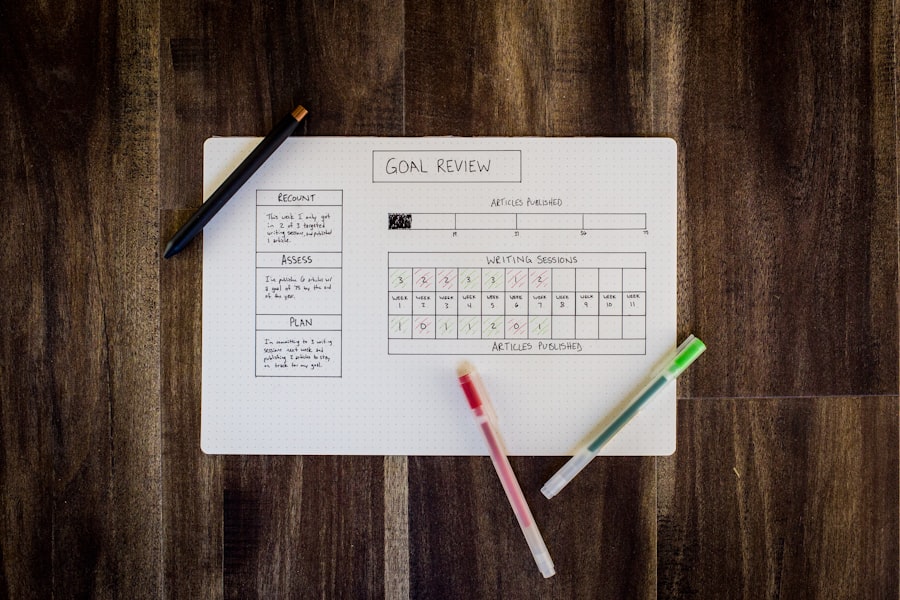When you embark on any journey, whether personal or professional, setting clear goals and priorities is essential. It serves as your compass, guiding you through the myriad of tasks and decisions you face daily. By defining what you want to achieve, you create a roadmap that helps you focus your energy and resources effectively.
Start by identifying your long-term objectives and breaking them down into smaller, manageable goals. This approach not only makes your aspirations feel more attainable but also allows you to celebrate small victories along the way, keeping your motivation high. Prioritization is equally important in this process.
Once you have a list of goals, assess their urgency and importance. You might find that some tasks are time-sensitive while others contribute more significantly to your overall objectives. By categorizing your goals, you can allocate your time and effort more efficiently.
This clarity will empower you to make informed decisions about where to direct your focus, ensuring that you are always working towards what truly matters.
Key Takeaways
- Setting clear goals and priorities is essential for staying focused and organized.
- Creating a structured daily routine helps in managing time effectively and staying on track.
- Utilizing time management techniques such as the Pomodoro Technique can improve productivity.
- Eliminating distractions and time-wasters is crucial for maintaining focus and efficiency.
- Taking regular breaks and rest is important for recharging and avoiding burnout.
Creating a Structured Daily Routine
A structured daily routine can be a game-changer in your quest for productivity. When you establish a consistent schedule, you create a sense of order that can help reduce stress and increase efficiency. Start by mapping out your day, allocating specific time slots for various activities, including work tasks, personal projects, and leisure.
This structure not only helps you stay organized but also allows you to anticipate what lies ahead, making it easier to manage your time effectively. Incorporating rituals into your routine can further enhance its effectiveness. For instance, beginning your day with a morning ritual—whether it’s meditation, exercise, or reading—can set a positive tone for the hours that follow.
Similarly, having a wind-down routine in the evening can help signal to your mind that it’s time to relax and recharge. By creating these habits, you not only improve your productivity but also foster a sense of balance in your life.
Utilizing Time Management Techniques

Time management techniques are invaluable tools that can help you maximize your productivity and achieve your goals more efficiently. One popular method is the Eisenhower Matrix, which encourages you to categorize tasks based on their urgency and importance. By distinguishing between what is urgent and what is important, you can prioritize effectively and avoid getting bogged down by less critical tasks.
This technique empowers you to focus on what truly matters, ensuring that your efforts align with your overarching objectives. Another effective time management strategy is time blocking. This involves allocating specific blocks of time for different activities throughout your day.
By dedicating uninterrupted periods to particular tasks, you can enhance your concentration and minimize the temptation to multitask. This focused approach not only boosts productivity but also allows for deeper engagement with the work at hand. Experimenting with various techniques will help you discover what resonates best with your working style and preferences.
Eliminating Distractions and Time-wasters
| Metrics | Results |
|---|---|
| Time spent on social media | 2 hours per day |
| Number of interruptions per hour | 5 |
| Time spent on non-work related tasks | 1 hour per day |
| Productivity level | Decreased by 20% |
In today’s fast-paced world, distractions are everywhere, threatening to derail your productivity and focus. Identifying and eliminating these distractions is crucial for maintaining a productive workflow. Start by assessing your environment—are there specific triggers that pull your attention away from your tasks?
Whether it’s social media notifications, cluttered workspaces, or noisy surroundings, taking proactive steps to minimize these distractions can significantly enhance your ability to concentrate. Additionally, consider implementing strategies to manage digital distractions. For instance, setting specific times to check emails or social media can help you resist the urge to constantly monitor these platforms throughout the day.
You might also find it beneficial to use apps designed to block distracting websites during work hours. By creating an environment conducive to focus, you empower yourself to make the most of your time and energy.
Taking Regular Breaks and Rest
While it may seem counterintuitive, taking regular breaks is essential for maintaining productivity over the long term. Working for extended periods without rest can lead to burnout and decreased efficiency. Instead, incorporate short breaks into your routine to recharge both mentally and physically.
These breaks allow your mind to reset, enhancing creativity and problem-solving abilities when you return to work. Moreover, prioritizing adequate rest is equally important. Sleep plays a vital role in cognitive function and overall well-being.
Ensure that you are getting enough quality sleep each night to support your productivity during the day. By recognizing the value of rest and breaks, you create a sustainable approach to productivity that fosters long-term success rather than short-lived bursts of activity.
Delegating Tasks and Responsibilities

As you strive for greater productivity, it’s essential to recognize that you don’t have to do everything yourself. Delegating tasks and responsibilities can free up valuable time and allow you to focus on higher-priority activities that align with your goals. Assess your workload and identify tasks that can be entrusted to others—whether it’s colleagues, team members, or even outsourcing certain responsibilities.
Effective delegation requires clear communication and trust in those you assign tasks to. Provide detailed instructions and expectations while allowing room for creativity and autonomy in how the task is completed. By empowering others to take on responsibilities, you not only lighten your load but also foster collaboration and growth within your team or community.
Using Technology to Streamline Processes
In an age where technology permeates every aspect of our lives, leveraging digital tools can significantly enhance your productivity. From project management software to communication platforms, technology offers a plethora of resources designed to streamline processes and improve efficiency. Explore various applications that cater to your specific needs—whether it’s organizing tasks, tracking progress, or facilitating collaboration with others.
Automation is another powerful aspect of technology that can save you time and effort. Identify repetitive tasks in your workflow that could benefit from automation—such as scheduling social media posts or sending reminders—and implement tools that can handle these processes for you. By embracing technology as an ally in your productivity journey, you can optimize your efforts and focus on what truly matters.
Implementing the Pomodoro Technique for Focus
The Pomodoro Technique is a time management method that encourages focused work sessions followed by short breaks. This technique involves working for 25 minutes—known as a “Pomodoro”—and then taking a 5-minute break before starting the next session. After completing four Pomodoros, take a longer break of 15-30 minutes.
This structured approach helps maintain concentration while preventing burnout. By using the Pomodoro Technique, you create a rhythm that enhances both focus and productivity. The short bursts of concentrated work allow you to tackle tasks with intensity while the breaks provide necessary downtime for mental rejuvenation.
Experimenting with this technique can help you discover how it fits into your workflow and may lead to improved efficiency in completing tasks.
Practicing Mindfulness and Stress Management
Incorporating mindfulness practices into your daily routine can have profound effects on both productivity and overall well-being. Mindfulness encourages present-moment awareness, helping you stay grounded amidst the chaos of daily life. Simple practices such as deep breathing exercises or meditation can reduce stress levels and enhance focus, allowing you to approach tasks with clarity and intention.
Additionally, developing effective stress management techniques is crucial for maintaining productivity over time. Identify activities that help you unwind—whether it’s exercise, spending time in nature, or engaging in hobbies—and make them a regular part of your routine. By prioritizing self-care and mindfulness, you create a supportive environment that fosters resilience and enhances your ability to navigate challenges.
Seeking Continuous Learning and Improvement
The pursuit of continuous learning is vital for personal growth and professional development. Embrace opportunities to expand your knowledge and skills through workshops, online courses, or reading relevant literature in your field. By staying curious and open-minded, you not only enhance your expertise but also cultivate adaptability in an ever-changing world.
Moreover, seeking feedback from peers or mentors can provide valuable insights into areas for improvement. Constructive criticism allows you to identify blind spots and refine your approach over time. By committing to lifelong learning and improvement, you position yourself for ongoing success while fostering a growth mindset that embraces challenges as opportunities for development.
Establishing Accountability and Tracking Progress
Establishing accountability is a powerful motivator in achieving your goals.
This external accountability creates a sense of responsibility that can drive you to stay committed to your goals even when motivation wanes.
Tracking progress is equally important in this process. Utilize tools such as journals or digital apps to monitor milestones achieved along the way. Reflecting on what you’ve accomplished not only boosts motivation but also provides insights into what strategies are working effectively for you.
By establishing accountability measures and tracking progress diligently, you create a framework for sustained success in reaching your goals. In conclusion, enhancing productivity requires a multifaceted approach that encompasses goal-setting, structured routines, effective time management techniques, and self-care practices. By implementing these strategies thoughtfully into your daily life, you empower yourself to navigate challenges with resilience while maximizing efficiency in pursuing your aspirations.
Remember that productivity is not merely about doing more; it’s about doing what matters most with intention and purpose.
For high achievers looking to enhance their productivity, it’s essential to adopt strategies that align with their ambitious goals. One effective approach is to prioritize tasks based on their impact and urgency, ensuring that the most critical tasks are completed first. Additionally, incorporating regular breaks and mindfulness practices can help maintain focus and prevent burnout. For more insights and detailed strategies, you can explore a related article on productivity tips for high achievers by visiting Productive Patty. This resource offers a wealth of information tailored to those striving for excellence in their personal and professional lives.
WATCH NOW! Nietzsche: Destroy Your Laziness Before It Destroys Your Career
FAQs
What are some productivity tips for high achievers?
Some productivity tips for high achievers include setting specific goals, prioritizing tasks, minimizing distractions, taking regular breaks, and practicing time management techniques.
How can high achievers improve their time management skills?
High achievers can improve their time management skills by using tools such as to-do lists, calendars, and time tracking apps, as well as by delegating tasks, setting boundaries, and learning to say no to non-essential commitments.
What are some strategies for minimizing distractions and staying focused?
Strategies for minimizing distractions and staying focused include creating a dedicated workspace, turning off notifications, setting specific work hours, using noise-cancelling headphones, and practicing mindfulness or meditation.
How can high achievers maintain a healthy work-life balance?
High achievers can maintain a healthy work-life balance by setting boundaries, scheduling regular leisure time, prioritizing self-care, and learning to disconnect from work during non-working hours.
What role does goal-setting play in productivity for high achievers?
Goal-setting plays a crucial role in productivity for high achievers by providing a clear direction, motivation, and a sense of accomplishment. Setting specific, measurable, achievable, relevant, and time-bound (SMART) goals can help high achievers stay focused and productive.




